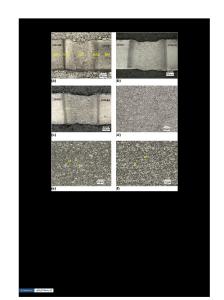Microstructures and mechanical properties of metal inert-gas arc welded joints of Mg alloy and ultra-high strength steel
- PDF / 757,141 Bytes
- 9 Pages / 584.957 x 782.986 pts Page_size
- 16 Downloads / 701 Views
The dissimilar MIG welding of Mg alloy and ultra-high strength steel was investigated. The results indicated that the Mg-steel joints had characteristics of welding-brazing and included weld zone, bond zone, and interface zone. The weld zone with an equiaxed grain structure mainly consisted of a-Mg and a-Mg 1 b-Mg17Al12 phases when AZ31 and AZ61 filler metals were used respectively. The interface zone presents a double-layer structures: the AlFe3 layer at steel side and the Mg(Fe, Al)O4 1 Mg3.1Al0.9 layer at Mg side, and their evolution process has been summarized. The joint strength was improved obviously at the heat input of 1987–2100 J/cm due to eliminating incomplete joining defects and cracks in the interface zone. With AZ61 filler metal, the weld Al content was 6.24%, the joint strength was elevated from 174 MPa for AZ31 filler metal to 201 MPa (83.8% of Mg alloy base metal), which is related to the increased Al promoting the interface reaction.
I. INTRODUCTION
Magnesium and its alloys, the lightest metal structural materials, have been used in the fields of transportation for vehicle lightening, because of their unique characteristics such as low density, high specific strength, and damping capacity.1–5 The steels are still dominant metal materials in the transport industry today. The ultra-high strength steel can not only achieve auto lightweight but also increase its collision safety performance, and is increasingly applied in automobile industry. Therefore, the hybrid structure of Mg alloy to ultra-high strength steel has a widely applied prospect in the field of transportation, and it has received remarkable attention to join Mg alloy and steel dissimilar metals. There are some difficulties encountered in dissimilar welding of Mg alloy and steel, which mainly result from the huge difference between their melting points (649 °C for Mg and 1535 °C for Fe) and the nearly zero solubility of Mg and Fe.6 In addition, Mg and Fe do not react with each other to form binary compounds at ambient pressure.7 The diffusion welding,8,9 friction stir welding,6,10 and resistance spot welding11 were used to join Mg alloy and steel. However, their application is limited by the geometry and size of workpiece. The hybrid laser-TIG welding12–15 and laser penetration brazing (LPB)16,17 were also used for joining Mg alloy to steel. The results showed that the Ni interlayer favors improving the microstructure Contributing Editor: Jürgen Eckert a) Address all correspondence to this author. e-mail: [email protected] DOI: 10.1557/jmr.2016.515
and tensile shear strength of Mg-steel joints produced by the hybrid laser-TIG welding. For the LPB, the transition layer at Mg/steel interface region consisted mainly of intermetallic compounds and metal oxides, and the joint strength reached a maximum of 185 MPa at 0.6 mm laser offset. Metal inert-gas arc welding (MIG Welding) is widely applied in automotive industries due to its high efficiency, low cost, and good applicability. Wang investigated MIG welding of AZ31B Mg alloy and Q235 low carb
Data Loading...











